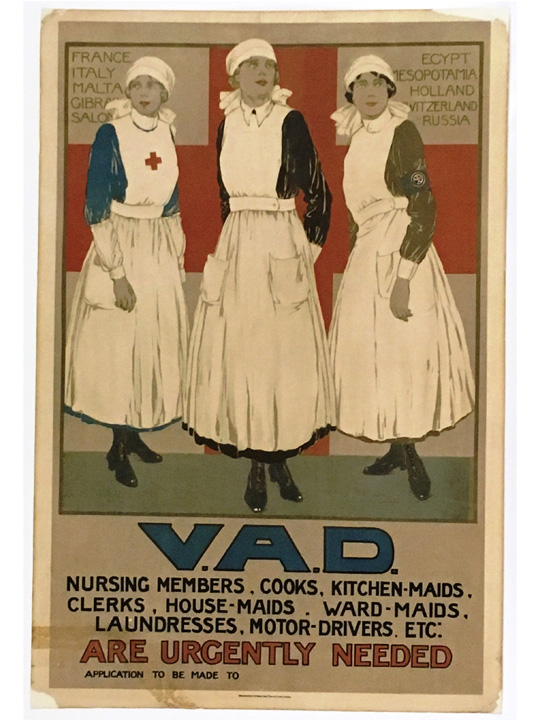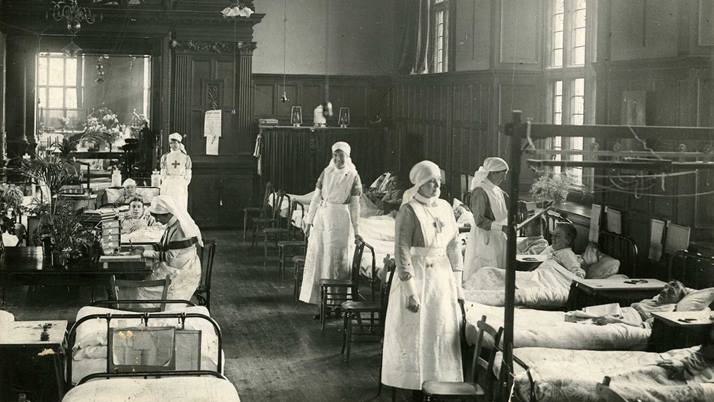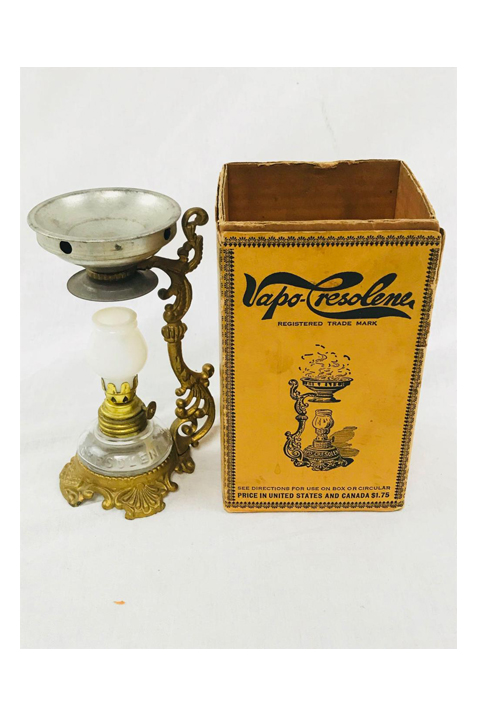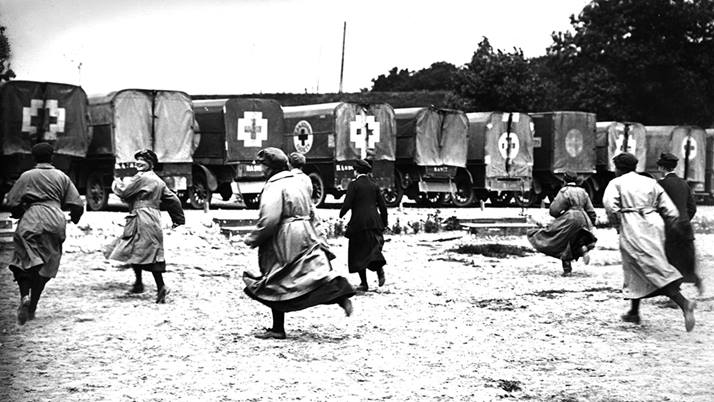'Spanish flu': The British Red Cross' work in the face of a global pandemic
Last updated 27 January 2021
The 1918 influenza pandemic - commonly known as 'Spanish flu' - is the most significant health event ever recorded. The British Red Cross's museum and archives curator Mehzebin Adam explains how we responded
The 1918 outbreak of influenza, the deadliest global pandemic in history, killed between 50 and 100 million people worldwide. Around 250,000 people died in Britain, and a large number were young and healthy adults.
The pandemic, which lasted from 1918 to 1920, killed more people than the First World War. It was first reported in Spain as the country was one of the few in Europe to remain neutral during the war, and therefore not subject to wartime censorship. Although the origins of the outbreak are uncertain, wartime conditions such as the mass movement of troops, and overcrowded trenches and hospitals, contributed to the rapid spread.
Just as the British Red Cross is providing vital relief to people affected by Covid-19 today, we played an essential role in caring for those affected by the influenza pandemic over 100 years ago.
A call for volunteers
British Red Cross VADs (Voluntary Aid Detachments) were already very involved in caring for the sick and wounded during the First World War. At the start of the pandemic, a request was made for the recruitment and training of more volunteers:
The British Red Cross's country director at the time, Lord Chilston, said: “In view of the possibility of an epidemic of influenza, it is suggested that county directors should ascertain through the commandants of the detachments, which of their members would be prepared to assist the medical officers and district nursing associations… It is important that members volunteering for work in an influenza epidemic should be inoculated beforehand.”

A VAD recruitment poster from the early 20th century
Joyce Sapwell, a British Red Cross VAD nurse during the First World War, wrote about her experiences working in a hospital in Aldershot as the Spanish flu of 1918 took hold.
“About one-third of the staff were down with it, and the hospital was full. We had one hundred and eight deaths in eight weeks… I had not even one orderly to help. Several patients became delirious, and if they got out of bed they usually died. I had to go from one ward… to the other all night long…This was a very hectic time, on the go all night.”
A tremendous sacrifice
Many VADs caught the virus while nursing patients and obituaries in the British Red Cross journals highlight the tremendous sacrifices they made:
The obituary of Miss Emma Long reads: “nursed through the war at the Esher Red Cross Hospital, where she never missed a day, and was the most devoted worker; this is in addition to domestic work at her home. On demobilisation, she went to nurse village families during the influenza epidemic, contracted the disease, and died on Easter Day.”

VADs at an auxiliary hospital in Oxford, between 1914 and 1918
Although VAD nurses were most affected, other Red Cross members also lost their lives. The obituary of Mr E.A. Alley, assistant honorary secretary of the East Lancashire branch, reads: “was especially concerned with the work of the men’s detachments, in the unloading of ambulance trains coming into Manchester, provision of staff for military hospitals, and the recruiting of orderlies for abroad.”
Supplying medical equipment to hospitals
The British Red Cross stores department, which was under huge demand during the pandemic, distributed large numbers of medical supplies to hospitals across the country as well as overseas.
There were few treatment options for patients with influenza in 1918. Most treatments were aimed at making patients as comfortable as possible by reducing fevers and alleviating pain. The British Red Cross museum collection holds examples of some of the medical equipment used to treat patients with respiratory illnesses.
THERE WERE FEW TREATMENT OPTIONS FOR PATIENTS WITH INFLUENZA IN 1918.
Vaporisers, like this one made by the Vapo-Cresolene company, were a popular treatment for diseases of the throat and respiratory system. The makers of the Vapo-Cresolene lamp claimed it would cure or considerably alleviate symptoms of influenza, whooping cough, asthma, diphtheria, and scarlet fever.

Dr Nelson’s Inhaler was first introduced in 1865 for the treatment of chest infections and diseases. The inhaler would be filled with boiling water and one of the several accepted treatments of the period, and the patient inhaled the steam directly as it emerged from the glass mouthpiece.
Before the use of saline intravenous infusions became widespread, keeping patients hydrated was difficult. Feeding cups made it easier for VAD nurses to get fluids and nutrients into patients who were too weak to sit upright. In addition to water, these cups were used to feed patients milk and beef tea.
Sending relief overseas
During the autumn and winter of 1918, every French and Belgian medical unit in military rest stations was full of patients suffering from influenza. The British Red Cross received a request for 400 beds for a rest station in France.
British Red Cross VADs working in hospitals in France were extremely busy treating patients with influenza as well as the large convoys of severely wounded men arriving from the front.
In November 1918, there was a severe outbreak of influenza among Swiss soldiers. The British Red Cross assisted the Swiss hospitals as much as possible, giving 1,338 items, including towels and clothing, which were much appreciated.

British Red Cross female ambulance drivers in Etaples, France, 1914-1918
Kindness will keep us together
In 1919 the League of Red Cross Societies was formed. Now called the International Federation of Red Cross and Red Crescent Societies, it widened the role of national Red Cross societies from their focus on wartime relief to peacetime work. The focus was not only on responding to health crises but also on preventing future ones by promoting health, hygiene and first aid.
The British Red Cross received a Supplemental Charter that extended its original objectives to include the improvement of health, the prevention of disease, and the mitigation of suffering throughout the world. Since then, the British Red Cross has delivered a range of health and social care services and supported the NHS. The organisation provided vital relief during previous pandemics such as the 1957 influenza, 2009 swine flu, and the recent Ebola outbreak.
Red Cross societies are at the forefront of the coronavirus response
During the current global Covid-19 pandemic, Red Cross societies around the world are at the forefront of the emergency response. The British Red Cross is helping with the emergency across the UK, from giving useful health advice to mobilising volunteers to help vulnerable people in society. While people everywhere face challenges during this crisis, the British Red Cross is determined to show the human capacity to support one another and how kindness will keep us together.
UK Coronavirus Response Appeal
The coronavirus pandemic is the biggest health emergency of our time. With your help, we’ll continue to provide vital support to those worst affected by the outbreak, wherever the need is greatest.
DONATE